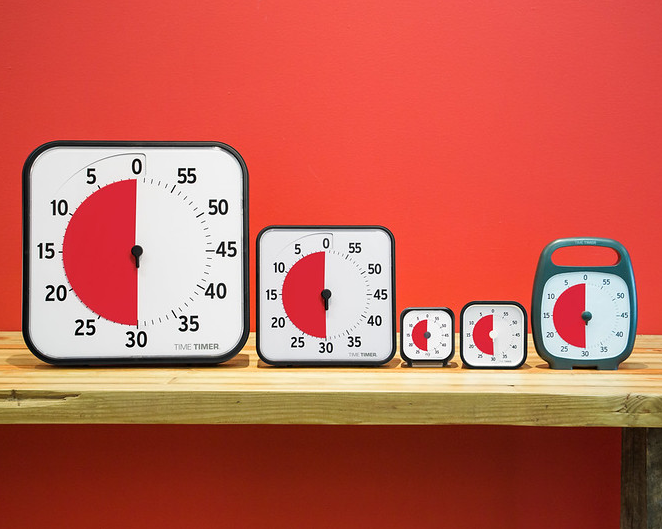In the business market it’s also recommended to use the Time Timer. Explore the Pomodoro technique. Work focussed for 25 minutes and then take a five minute break.
If you’re like most people, time management can be a challenge. Odds are you’re bombarded with work tasks, personal projects, lengthy to-do lists and constant emails flooding your inbox.
So, how do you get it all done in the most efficient manner?
One possible solution is to use a popular time blocking system called the Pomodoro Technique. In this article, I’ll talk about how the 25-minute “Pomodoro habit” can help you quickly complete tasks and get things done in a streamlined fashion.
Why is Effective Time Management Important?
A few years back, I discovered a simple truth called Parkison’s Law. It states:
Work expands so as to fill the time available for its completion.
Put succinctly, this rule means that the more time you “give” a project, the longer you’ll take to complete it. Have a deadline a week from now? Odds are you’ll take the full week to do it.
The best way to combat Parkinson’s Law is to manufacture strict deadlines with yourself and to literally have a ticking clock in the background as you work on each task. Not only will this help you become more productive, you’ll also “get more time” that can be spent doing the fun things in life.
Think of it this way:
There are only 675,450 hours in the average human life. Every hour that’s wasted is an hour you won’t get back. If you’re working hard every day but not getting measurable results, then you’re wasting your life—one hour at a time.
The solution is simple:
Stop randomly working on projects. Instead, create a plan for the important tasks and work on each with a completely focused mindset. And the best tool for doing this is through the Pomodoro Technique.
What is the Pomodoro Technique?
In the late 1980’s, Francesco Cirillo first came up with the Pomodoro System. Cirillo came up with the name (which is an Italian word for “tomato”) because he utilized a tomato-shaped egg timer when managing his time.
The idea behind the Pomodoro Technique is to break down all of your tasks into 25 minute time blocks. Between each time block, there is a five minute break. And after completing four Pomodoros you take a longer break—usually 15 to 30 minutes.
In theory, this strategy works because you completely focus on one task (like writing) without shifting focus or multitasking. When the clock is ticking, you ignore the urge to check email, hop on Facebook, answer text messages or do any other distracting activity. You’re in the zone and completely focused.
I have to admit, I was a bit skeptical when I first heard about the Pomodoro Technique. I used to work on tasks whenever I felt like it. Sometimes that meant two hours of uninterrupted work and other times it was for a few minutes, while watching television.
However, after using this technique for over three years, I can honestly say it’s been a “game changer” when it comes to improving my personal productivity. It doesn’t matter what task I’m doing—writing, answering email, social media or marketing—the ticking clock in the background keeps me focused on the task at hand.
If you decide to implement this system you’ll be able to:
- Eliminate the multi-tasking habit.
- Focus on the task at hand.
- Get more things done because you’ll have a sense of urgency.
- Avoid the perfectionist mindset by overly “fine-tuning” a project.
- Build higher levels of willpower and concentration.
- Decrease stress levels because you’re doing one thing at a time.
That just a taste of what your life could be like by using the Pomodoro technique. So let’s talk about to develop this time-blocking habit.
Pomodoro Technique in Five Simple Steps
Here’s the recommended process for following the Pomodoro method:
- Choose your task and total time to work on it.
- Set a timer to 25 minutes (either with an egg timer or with an app).
- Work on the task for 25 minutes. Avoid all distractions and urges to multi-task.
- Take a 5 minute break for energy renewal, start another Pomodoro.
- Take a 20-30 minute break after completing four Pomodoros.
Simple, but very effective. When you use this technique you’ll see a dramatic improvement in your productivity and ability to get things done.
(My) 4 Rules for the Pomodoro Technique
Like any system, there are rules to follow and rules to ignore. That’s why I recommend my variation on the above system. Here are four guidelines that can maximize your results:
Rule 1: Breaks are NOT Optional
When that buzzer rings, stop work, get up and take a break. You need this time for your mind to relax and to get energized for that next task. Use it to: Do simple exercises, grab a snack, go to the restroom, stretch or make a cup of tea. It really doesn’t matter what you do, just as long as you’re taking a break.
Rule 2: Time Length = Challenge of Task
What I’m about to suggest breaks the primary rule of the Pomodoro Technique…so use it at your own discretion:
The way I use this method is to work in multiples of the 25-minute block.
The actual amount of time I spent fully-focused on a task depends on its level of difficulty. Easy tasks (i.e.; a low level of concentration) can be can be completed in 50-minute (2 Pomodoros) or 1 hour and 15-minute (3 Pomdoros) blocks of time. Harder tasks (i.e.; a high level of concentration) can be completed using the standard 25-minute block of time. Really the number of Pomodoros you do should relate to how long you can focus on a task without feeling distracted.
EXAMPLE:
Writing isn’t an easy task for me because it requires a high level of concentration. So whenever I’m writing, I’ll do it in 25- or 50-minute blocks of time (1 to 2 Pomodoros).
On other hand, answering email and corresponding over social media are simple easy to complete. So, I’ll often set my clock for 3 Pomodoros (1 hour and 15 minutes) and get a whole lot of correspondence completed in a short burst of time.
Rule 3: Partial Pomodoros Do Count
Again, I’m about to recommend a strategy that doesn’t align with the rules of the Pomodoro Technique. One thing that Francesco Cirillo is adamant about is that half-completed Pomodoros don’t count. Let’s say you get interrupted 10 minutes into a task, then that means you get no “credit” for the task and have to start over.
I completely disagree with this statement.
In my opinion, 10 minutes of work is still work. If you get interrupted, all you have to do is record your time and then add it to the next Pomodoro. Once you’ve completed that Pomodoro, you’ll get credit for doing two Pomodoros.
Here’s how this works:
- You’re writing for 15 minutes and get an important call.
- You quickly write down “15 min” on your to-do list and talk to that person.
- You finish the conversation and get back to work.
- You start a new Pomodoro, adding the time from the uncompleted task.
- In this case it would be 35 minutes [25 minutes (1st Pomodoro) – 15 minutes + 25 minutes (2nd Pomodoro) = 35 minutes].
I’ll admit this process would probably piss off many “hard-line Pomodoro fanatics,” but I feel it’s important to develop the mindset that you can do quality work in small blocks of time (like 5- to 10-minutes). When you give yourself “credit” for making an effort—even in a miniscule amount of time—you’ll be more likely to maximize those small blocks of time that you get throughout the day.
Rule 4: Batch Related Pomodoros
Tasks that take less than 25 minutes should be grouped together instead of being done separately.
For instance, I have a task that’s labeled “communication,” which includes talking to people through email, Twitter, Pinterest, Google+ and Facebook. Each site might only take five minutes of my time, so I’ve developed a system where I run a few back-to-back Pomodoros and go through all of them at once.
Pomodoro Technique
The great thing about the Pomodoro method is you don’t need a fancy tool or guide to get started. Really, the only “requirement” is to use an Time Timer. So let’s go over the benefits of both.
Why an Time Timer?
There are two reasons why an Time Timer works well for a Pomodoro. First, the physical act of winding a timer gives you that mental commitment to start working on the task. Second, the “tick-tick-tick” sound of the Time Timer creates a sense of urgency and makes you stay committed to the task.
Source: https://www.developgoodhabits.com/pomodoro-technique/

